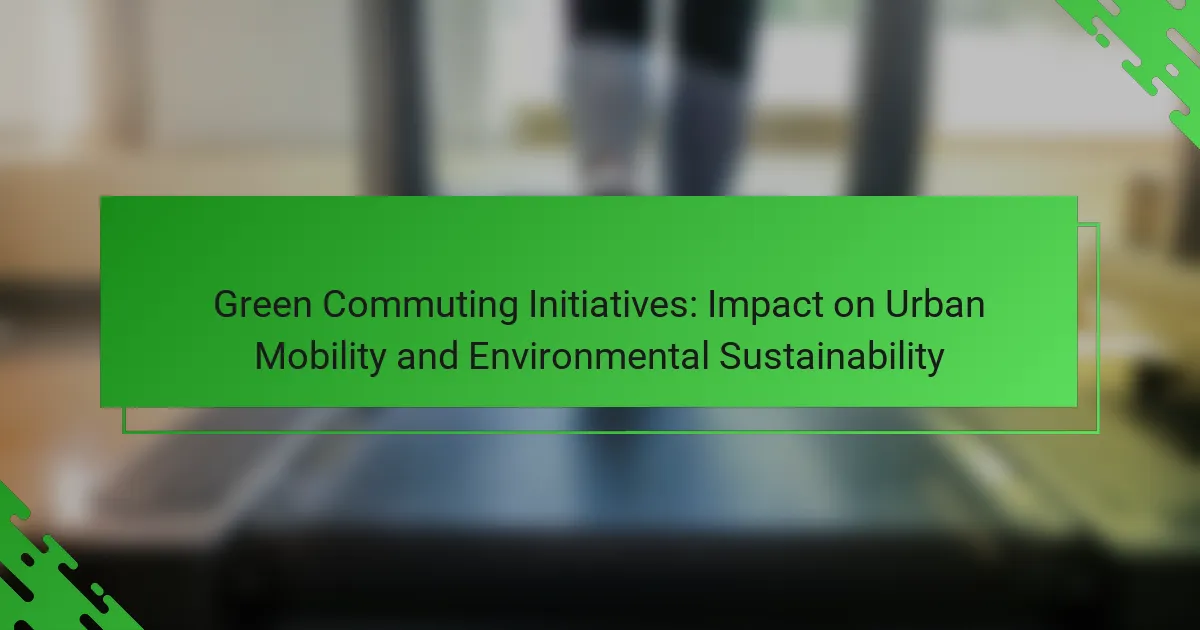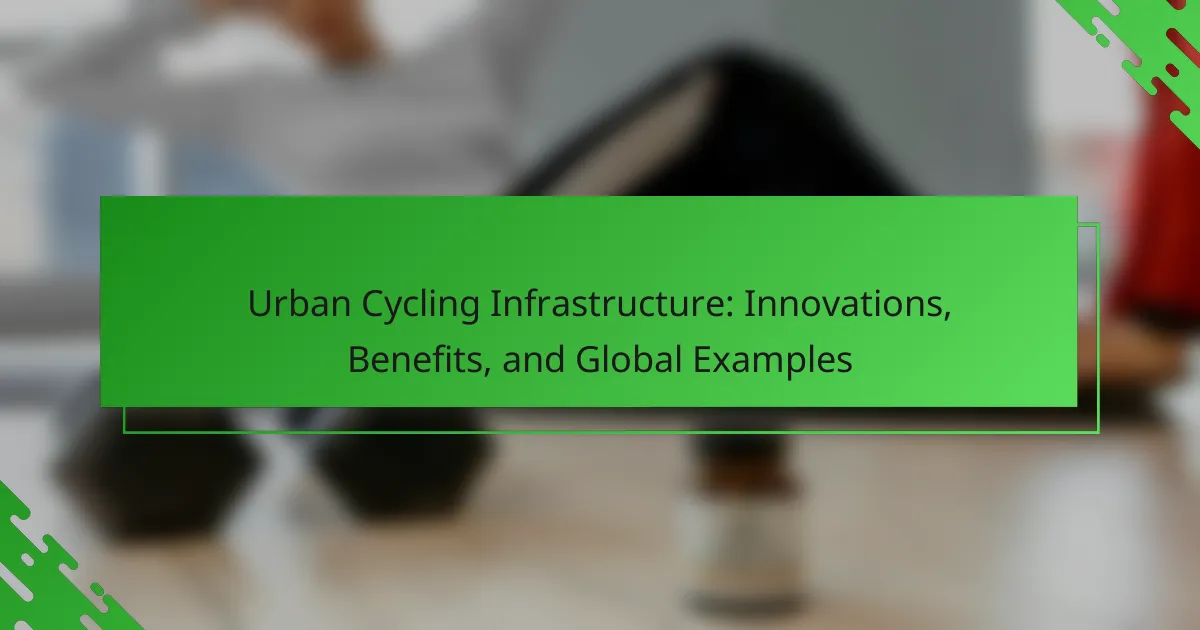Non-profit cycling advocacy plays a crucial role in promoting cycling as a sustainable transportation option. This article explores effective strategies for community outreach, collaboration with local governments, and educational initiatives. It highlights successful campaigns that have increased cycling participation and improved community health. Additionally, it addresses the challenges these organizations face and innovative approaches for future advocacy efforts.
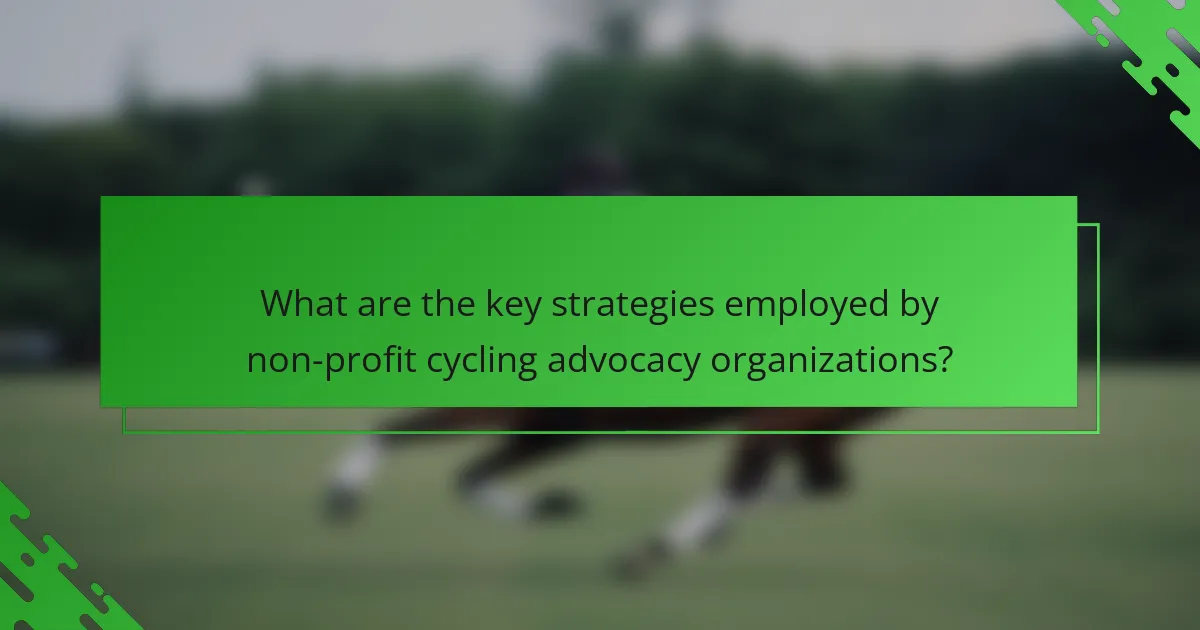
What are the key strategies employed by non-profit cycling advocacy organizations?
Non-profit cycling advocacy organizations employ various strategies to promote cycling and enhance community engagement. Key strategies include community outreach programs, collaboration with local governments, educational initiatives, and advocacy for infrastructure improvements.
Community outreach programs often involve organizing events, such as group rides and workshops, to raise awareness about cycling benefits. Collaboration with local governments helps secure funding and policy support for cycling infrastructure. Educational initiatives focus on teaching cycling safety and promoting the environmental advantages of cycling. Advocacy for infrastructure improvements aims to create safer cycling environments through dedicated bike lanes and improved signage.
These strategies collectively enhance community impact by increasing cycling participation and fostering a culture of active transportation.
How do grassroots movements influence cycling policy?
Grassroots movements significantly influence cycling policy by advocating for community needs and promoting sustainable transportation. They mobilize local support, raise awareness, and push for legislative changes. For example, organizations like the League of American Bicyclists use community engagement to shape policies that enhance cycling infrastructure. Their efforts often lead to increased funding for bike lanes and safety programs, demonstrating the impact of grassroots advocacy on local and national cycling policies.
What role does community engagement play in advocacy success?
Community engagement is crucial for advocacy success as it fosters trust, mobilizes support, and amplifies voices. Engaged communities can effectively influence policy changes and promote cycling initiatives. For example, successful non-profit cycling advocacy often involves organizing local events, workshops, and outreach programs that educate and involve residents. These efforts create a sense of ownership and investment in cycling infrastructure, leading to sustained advocacy momentum. Additionally, local partnerships can enhance resource sharing and increase visibility, ultimately driving impactful change in cycling policies and community health.
Which partnerships are most effective for advocacy initiatives?
Collaborative partnerships with local businesses, government agencies, and community organizations are most effective for advocacy initiatives. These alliances enhance resource sharing, increase visibility, and amplify community engagement. For instance, partnerships with local bike shops can provide incentives for cycling, while collaboration with city planners can lead to improved infrastructure. Engaging diverse stakeholders fosters a unified approach, maximizing advocacy impact.

What are some notable success stories from non-profit cycling advocacy?
Non-profit cycling advocacy has led to significant community improvements through various successful initiatives. One notable success story is the “Bike to Work” campaign, which increased commuter cycling by 30% over two years in a major city. Another example is the “Safe Routes to School” program, which enhanced safety for children and resulted in a 50% rise in biking among students. Additionally, the advocacy group’s efforts in lobbying for dedicated bike lanes have been instrumental in reducing traffic accidents by 25% in urban areas. These stories highlight the impactful strategies used by non-profit organizations to promote cycling and improve community health.
How did local advocacy groups achieve major policy changes?
Local advocacy groups achieved major policy changes through strategic coalition building, community engagement, and targeted campaigns. They united diverse stakeholders to amplify their voices and influence decision-makers. Success stories include increased funding for cycling infrastructure and the implementation of safer cycling laws. These efforts not only improved community health but also enhanced environmental sustainability.
What impact have successful campaigns had on cycling infrastructure?
Successful campaigns have significantly improved cycling infrastructure by increasing funding, awareness, and community engagement. These initiatives often lead to the development of dedicated bike lanes, safer crossings, and enhanced connectivity in urban areas. For instance, cities that have embraced advocacy efforts report a rise in cycling rates, which contributes to reduced traffic congestion and improved public health. Moreover, successful campaigns often inspire policy changes that prioritize cycling as a viable mode of transportation. This community impact fosters a culture of cycling, encouraging more residents to adopt sustainable commuting practices.
Which events have significantly raised awareness for cycling issues?
Events that have significantly raised awareness for cycling issues include advocacy rides, community workshops, and national cycling conferences. These gatherings promote safety, infrastructure improvements, and environmental benefits. For example, the “Ride of Silence” honors cyclists killed or injured on the road while advocating for safer conditions. Events like “Bike to Work Day” encourage commuting by bike, showcasing its health and environmental advantages. Additionally, local film festivals highlighting cycling documentaries foster community engagement and discussion on cycling-related topics.
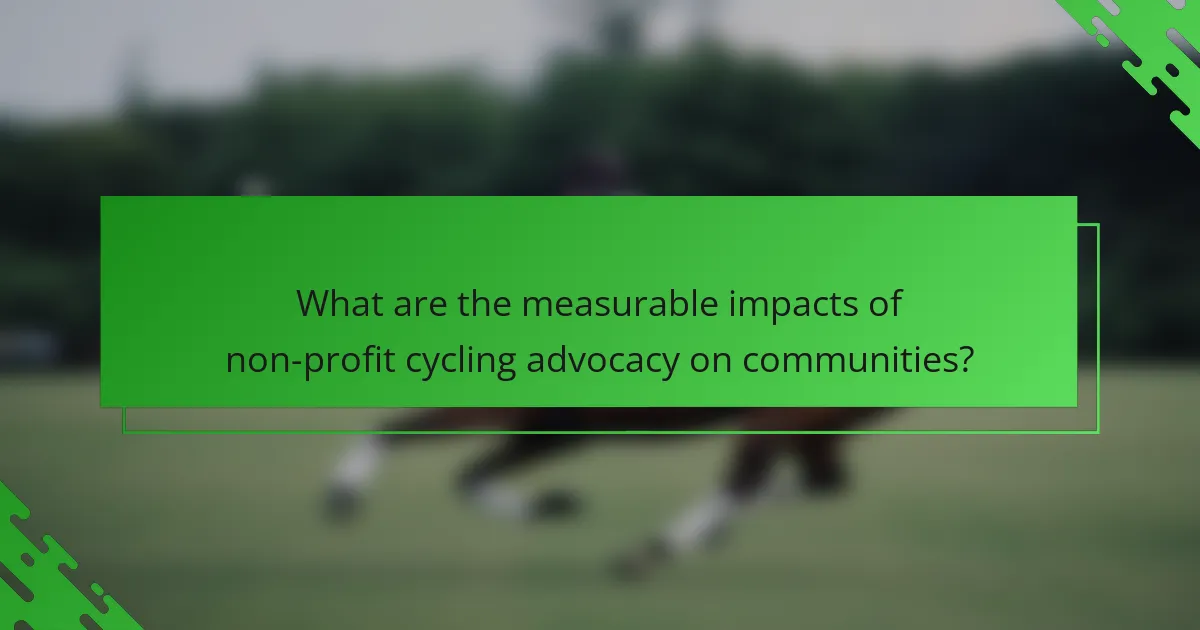
What are the measurable impacts of non-profit cycling advocacy on communities?
Non-profit cycling advocacy significantly enhances community health, safety, and social cohesion. These organizations improve access to cycling infrastructure, leading to increased ridership and reduced traffic congestion.
Studies show that cities with active cycling advocacy experience a 20% increase in cycling rates. This shift contributes to lower carbon emissions and improved air quality. Furthermore, advocacy efforts often result in safer cycling environments, reducing accidents by up to 30%.
Community engagement initiatives foster social connections, encouraging diverse populations to participate in cycling activities. As a result, non-profit cycling advocacy not only promotes sustainable transportation but also strengthens community bonds.
How does cycling advocacy contribute to public health?
Cycling advocacy significantly enhances public health by promoting active transportation and reducing pollution. This advocacy encourages communities to embrace cycling, leading to increased physical activity levels among residents. Research shows that higher cycling rates correlate with lower obesity rates and improved cardiovascular health. Additionally, cycling reduces vehicular emissions, contributing to cleaner air and decreased respiratory issues. Community programs that support cycling infrastructure, such as bike lanes and repair stations, further enhance accessibility and safety, fostering a healthier population overall.
What economic benefits arise from increased cycling participation?
Increased cycling participation generates significant economic benefits, including reduced healthcare costs, increased local business revenues, and enhanced job creation in cycling-related sectors. Communities with more cyclists experience lower rates of obesity and related diseases, leading to savings in healthcare expenditures. Additionally, local shops and cafes benefit from increased foot traffic, boosting sales. Cycling infrastructure projects create jobs in construction and maintenance, further stimulating the economy.
Which social changes have been driven by cycling advocacy efforts?
Cycling advocacy efforts have driven significant social changes, including increased community engagement and improved public health. These initiatives promote sustainable transportation, leading to reduced traffic congestion and enhanced air quality. For example, cities with active cycling programs report higher levels of physical activity among residents, contributing to overall well-being. Additionally, cycling advocacy fosters inclusivity by addressing transportation equity, ensuring access for underserved populations.
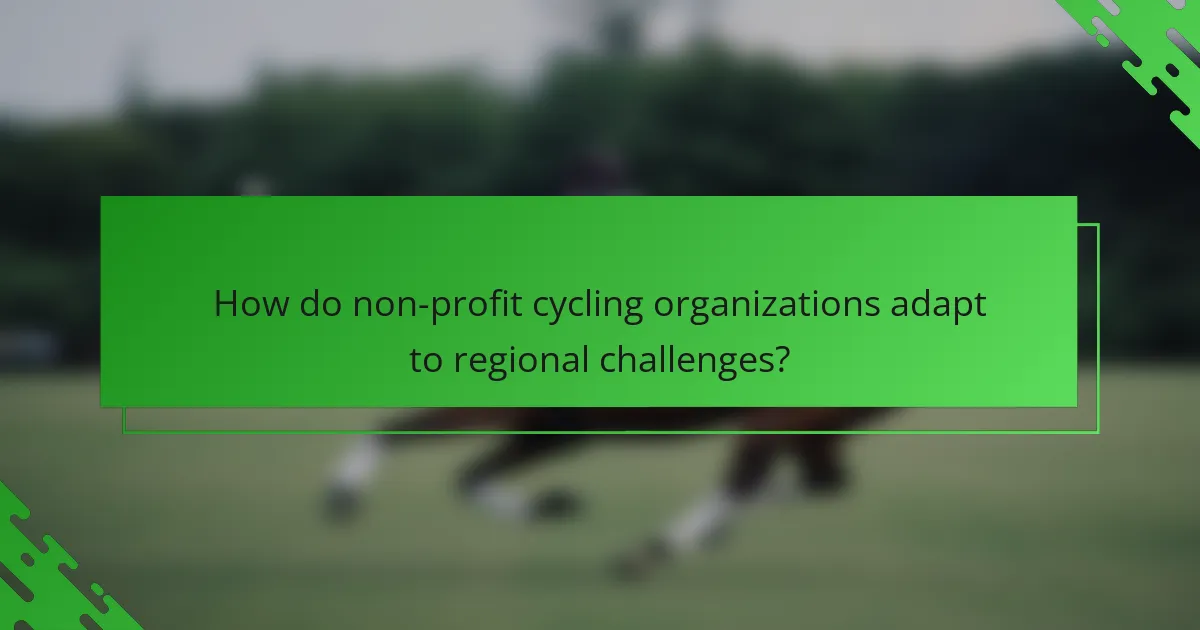
How do non-profit cycling organizations adapt to regional challenges?
Non-profit cycling organizations adapt to regional challenges by tailoring their advocacy strategies to local needs. They conduct community assessments to identify specific issues, such as road safety or access to cycling infrastructure.
These organizations often collaborate with local governments to influence policy changes that support cycling. For instance, they may advocate for dedicated bike lanes or improved signage. Success stories include cities where cycling advocacy led to increased ridership and safer roads.
Moreover, they leverage community events and educational programs to promote cycling culture. Engaging local cyclists fosters a sense of ownership and encourages participation in advocacy efforts. As a result, these organizations create a more supportive environment for cycling in their regions.
What unique strategies are used in urban versus rural advocacy?
Urban and rural advocacy for non-profit cycling employs distinct strategies tailored to their environments. Urban advocacy often focuses on policy change, infrastructure development, and community engagement through events. In contrast, rural advocacy emphasizes building local networks, promoting safety, and addressing unique transportation challenges.
Urban strategies include coalition building with local governments and businesses to enhance cycling infrastructure, such as bike lanes and parking facilities. Success stories often highlight city-wide events that raise awareness and foster community participation.
Rural strategies prioritize grassroots initiatives, leveraging local knowledge to promote cycling as a sustainable transport option. This involves organizing community rides and educational programs to improve cycling safety. Unique challenges, such as limited resources and fewer cyclists, shape these advocacy efforts.
How do cultural attitudes towards cycling influence advocacy approaches?
Cultural attitudes towards cycling significantly shape advocacy approaches by influencing public perception and policy support. In regions where cycling is viewed positively, advocacy efforts often focus on promoting infrastructure and safety measures. For instance, cities with high cycling acceptance frequently see successful campaigns for bike lanes and community events. Conversely, in areas where cycling is less embraced, advocacy may prioritize education and awareness to shift cultural norms. Effective advocacy strategies adapt to these cultural contexts, utilizing community engagement to foster a supportive environment for cycling initiatives.
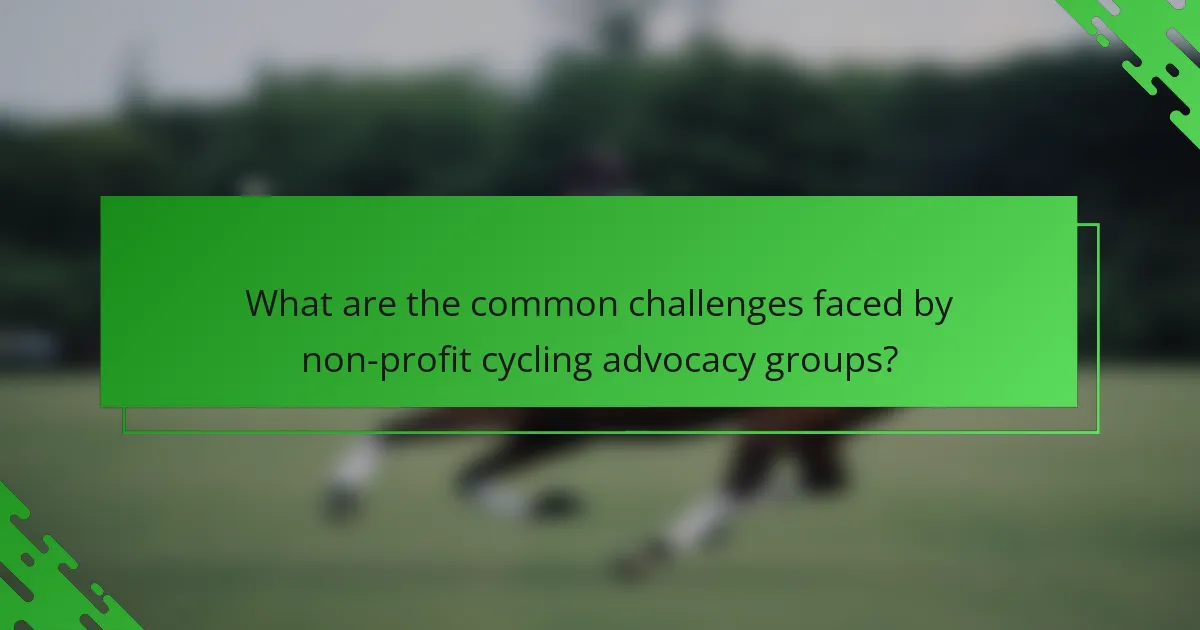
What are the common challenges faced by non-profit cycling advocacy groups?
Non-profit cycling advocacy groups commonly face funding shortages, volunteer recruitment challenges, and policy barriers. These obstacles hinder their ability to promote cycling as a viable transportation option. Additionally, they often struggle with community engagement and awareness about cycling benefits. Effective strategies to overcome these challenges include building partnerships, leveraging social media, and focusing on local advocacy efforts.
How do funding limitations affect advocacy efforts?
Funding limitations significantly hinder advocacy efforts by restricting resources for outreach, education, and program implementation. Non-profit cycling advocacy relies on financial support to mobilize communities and promote cycling initiatives. Without adequate funding, organizations face challenges in developing campaigns that raise awareness about cycling benefits and safety. Limited budgets can also reduce the capacity to engage with stakeholders, diminishing the impact of advocacy efforts. Furthermore, funding constraints may lead to prioritizing short-term goals over long-term sustainability, affecting community engagement and advocacy outcomes.
What strategies are used to overcome resistance from local governments?
Non-profit cycling advocacy groups often use collaborative strategies to overcome resistance from local governments. Building relationships with local officials fosters trust and understanding.
Engaging community stakeholders through public forums can gather support and showcase the benefits of cycling infrastructure. Presenting data on economic and health impacts strengthens the case for cycling initiatives.
Utilizing success stories from other regions can demonstrate feasibility and effectiveness. Tailoring proposals to align with local government goals enhances acceptance.
Involving local businesses and residents in advocacy efforts creates a united front, making it harder for officials to dismiss cycling projects.
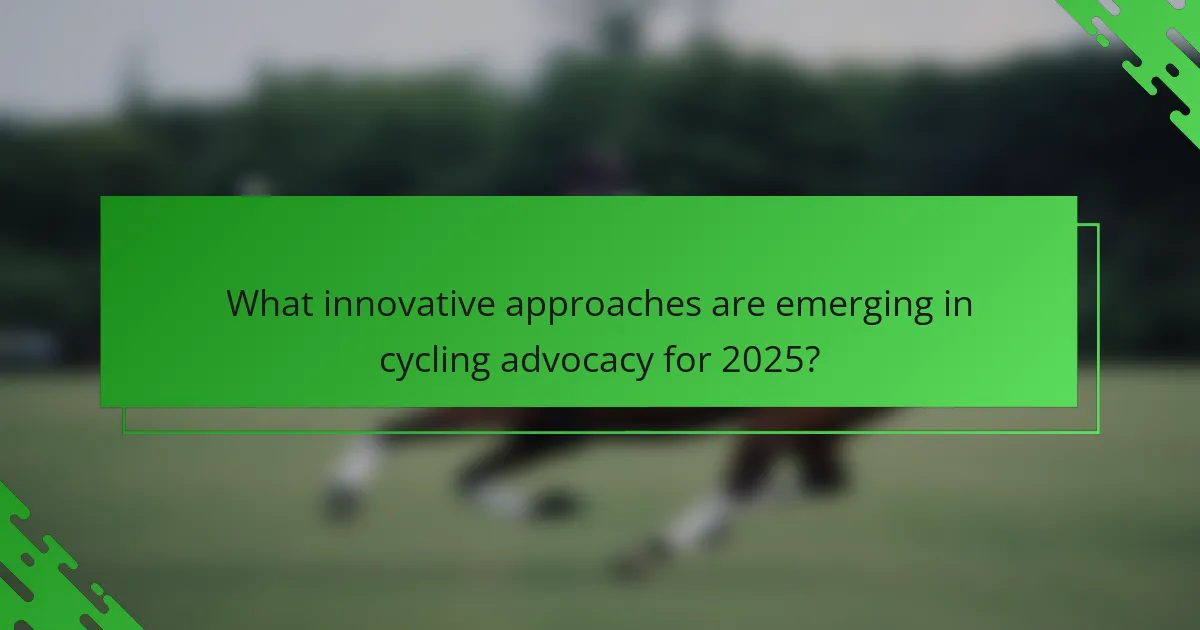
What innovative approaches are emerging in cycling advocacy for 2025?
Innovative approaches in cycling advocacy for 2025 focus on community engagement, technology integration, and policy change. Non-profit organizations are utilizing social media campaigns to raise awareness and encourage participation. Data-driven strategies are emerging, using analytics to identify cycling trends and improve infrastructure. Collaborative efforts with local governments are fostering safer cycling environments through advocacy for better policies and funding. Additionally, initiatives promoting equity in cycling access are gaining traction, ensuring underrepresented communities benefit from cycling resources.
Which technologies are enhancing advocacy efforts?
Technologies enhancing advocacy efforts include social media platforms, data analytics tools, and mobile applications. Social media enables broad outreach and community engagement. Data analytics provides insights into trends and demographics, improving targeted campaigns. Mobile applications facilitate real-time communication and mobilization of supporters. These technologies collectively strengthen advocacy initiatives and community impact.
How are social media platforms shaping community engagement?
Social media platforms significantly enhance community engagement for non-profit cycling advocacy. They provide tools for outreach, storytelling, and mobilization, allowing organizations to connect with supporters and promote initiatives effectively.
For instance, platforms like Facebook and Instagram enable non-profits to share success stories, increasing visibility and community involvement. Engaging content, such as videos and testimonials, fosters a sense of belonging among followers.
Additionally, social media facilitates real-time interaction, encouraging discussions around cycling issues and events. This interactive element empowers communities to voice concerns and collaborate on solutions, strengthening advocacy efforts.
Moreover, analytics tools on these platforms allow organizations to measure engagement and adjust strategies accordingly. This data-driven approach helps non-profits optimize their outreach and maximize community impact.
What role do youth programs play in future advocacy initiatives?
Youth programs significantly enhance future advocacy initiatives by fostering leadership skills and community engagement. These programs empower young individuals to understand cycling advocacy’s importance and take active roles in promoting sustainable transportation. They create a pipeline of passionate advocates who can influence policy and inspire their peers. Success stories from various non-profit organizations illustrate how youth involvement leads to increased awareness and support for cycling initiatives. Programs that integrate hands-on experiences, mentorship, and educational resources cultivate a generation committed to advocating for cycling-friendly environments.
What best practices should non-profit cycling advocates follow for maximum impact?
Non-profit cycling advocates should focus on community engagement, effective communication, and measurable outcomes for maximum impact. Building strong local partnerships enhances visibility and support. Regularly sharing success stories fosters inspiration and motivates participation. Implementing data-driven strategies ensures advocacy efforts align with community needs and priorities.

